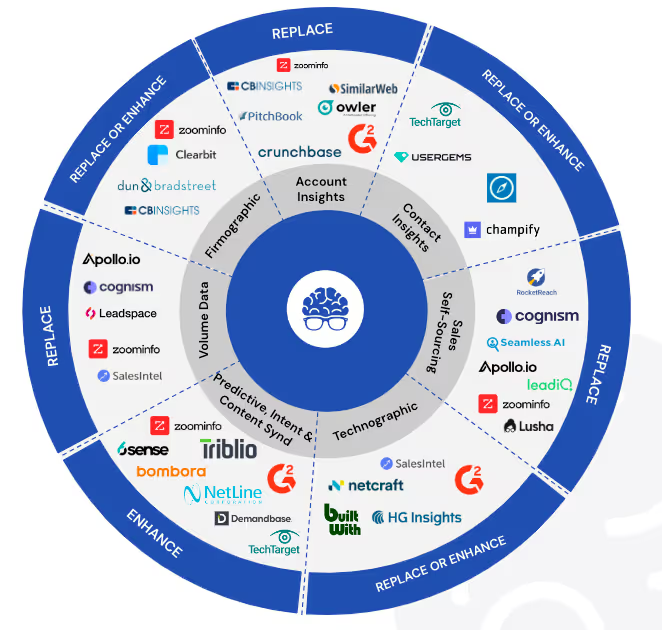The go-to-market (GTM) landscape has undergone rapid transformation in recent years, driven by the rise of AI, data-driven decision-making, and advanced technologies for sales and marketing. Yet, despite the availability of sophisticated tools and strategies, many GTM teams still struggle to adapt. The root cause? Old habits, outdated processes, and misalignment across teams.
This blog explores the common mistakes GTM teams make in today’s environment and how to overcome them to thrive in an era dominated by signal selling and account segmentation.
1. Relying on Outdated Data Models
A pervasive mistake is relying on outdated data sources like LinkedIn, Crunchbase, or basic firmographics (such as revenue figures and employee headcount) to segment accounts. While these sources provide a starting point, they fail to capture the nuances of modern businesses, especially in an era where businesses are more dynamic than ever.
Example: As Eliza Cooke-Yarborough from Enigma pointed out in a recent webinar, companies relying solely on publicly available revenue data may end up with inaccurate insights. Enigma's dataset, which incorporates 40% of all U.S. consumer credit card transactions, offers a more accurate reflection of a company’s true growth and performance, especially for small and medium-sized businesses (SMBs).
Solution: GTM teams need to integrate real-time, behavior-based signals—such as transaction data, hiring trends, and web activity—into their account segmentation process. This ensures that you're targeting companies that not only meet your size and industry criteria but also show signs of being ready to purchase.
2. Overly Broad Targeting
Another pitfall is casting too wide of a net. Many teams continue to use broad targeting criteria like industry, title, or geography. While this can yield a large number of leads, the quality of those leads is often low, resulting in high churn rates and wasted resources.
As Scott Martinis noted in the webinar, simply filtering by title, size, and industry is no longer enough. In fact, his analysis with a B2B client revealed that 80% of their marketing-qualified leads (MQLs) had no significant commonalities with their best customers.
Solution: To improve lead quality, you need to narrow your focus. Start by analyzing your best-fit customers. Look for key attributes such as:
- Do they have an outbound sales team?
- Are they investing in new technology?
- Are they actively growing their team or launching new products?
Once you’ve identified these characteristics, you can use tools like LeadGenius to target similar companies more precisely.
3. Misaligned Team Collaboration
A major roadblock to GTM success is misalignment between teams. Marketing, sales, and revenue operations often operate in silos, with each department having its own metrics, tools, and strategies. This disconnect can lead to a cycle of poor performance: marketing generates unqualified leads, sales struggles to close deals, and customer success faces higher churn rates.
Zeb Couch emphasized in the webinar that many teams perpetuate a vicious cycle where salespeople close deals with poorly qualified customers, who then churn quickly, leading to more pressure on marketing to fill the top of the funnel—without changing the approach that caused the problem in the first place.
Solution: Alignment is critical. GTM teams should collaborate to develop a shared Ideal Customer Profile (ICP) based on data from all departments, including customer success. This shared ICP should define not only company size, industry, and revenue but also more granular attributes like technology stack, business model, and growth trajectory.
By ensuring that all teams are aligned around a common understanding of the target customer, you can dramatically improve the efficiency and effectiveness of your GTM efforts.
4. Ignoring In-Market Signals
Signal selling, or the practice of using intent signals to prioritize outreach, has become a hot topic in GTM strategy. However, many teams either overuse or misuse these signals. They may rely on a single data point (e.g., a job change or a funding announcement) to determine if a company is in-market, which can lead to wasted effort.
Martinis warned against over-indexing on one signal alone, saying, "You can’t just rely on a signal; you have to infer a problem and create context around it."
Solution: The best GTM teams are using multiple signals—both first- and third-party data—to build a robust understanding of a prospect’s readiness to buy. Examples of useful signals include:
- Recent product launches or funding announcements
- Key hires (e.g., new VPs of sales or marketing)
- Increased website traffic or social media engagement
- Transaction growth, as identified by tools like Enigma
These signals can be used to tailor your messaging and prioritize outreach to the accounts that are most likely to convert.
5. Failing to Personalize Messaging
Personalization has been a buzzword in GTM for years, yet many teams fail to go beyond superficial tweaks like adding a prospect’s name to an email. In today’s competitive landscape, this level of personalization is not enough to stand out.
A case shared during the webinar involved Square’s early sales efforts, where they used Yelp data to identify a restaurant's top-selling menu item. By referencing the item in their outreach, they achieved much higher engagement and response rates.
Solution: Use the signals you’ve collected to craft highly personalized, relevant messages. Whether it’s referencing a company’s recent product launch or calling out a specific business challenge you know they’re facing, the more relevant your outreach, the higher your chances of success.
6. Neglecting Feedback Loops
Finally, many GTM teams fail to create feedback loops that allow them to continuously refine their approach. As a result, they get stuck in a cycle of doing more of the same, even when it’s not working.
Solution: Establish feedback mechanisms between marketing, sales, and customer success. Sales teams should regularly share insights from their conversations, customer success should report on churn and retention trends, and marketing should adjust targeting and messaging accordingly.
By addressing these common mistakes, GTM teams can significantly improve their targeting, messaging, and overall efficiency. In today’s competitive environment, the key to success lies in leveraging real-time signals, aligning teams around a shared strategy, and continuously optimizing based on data.




